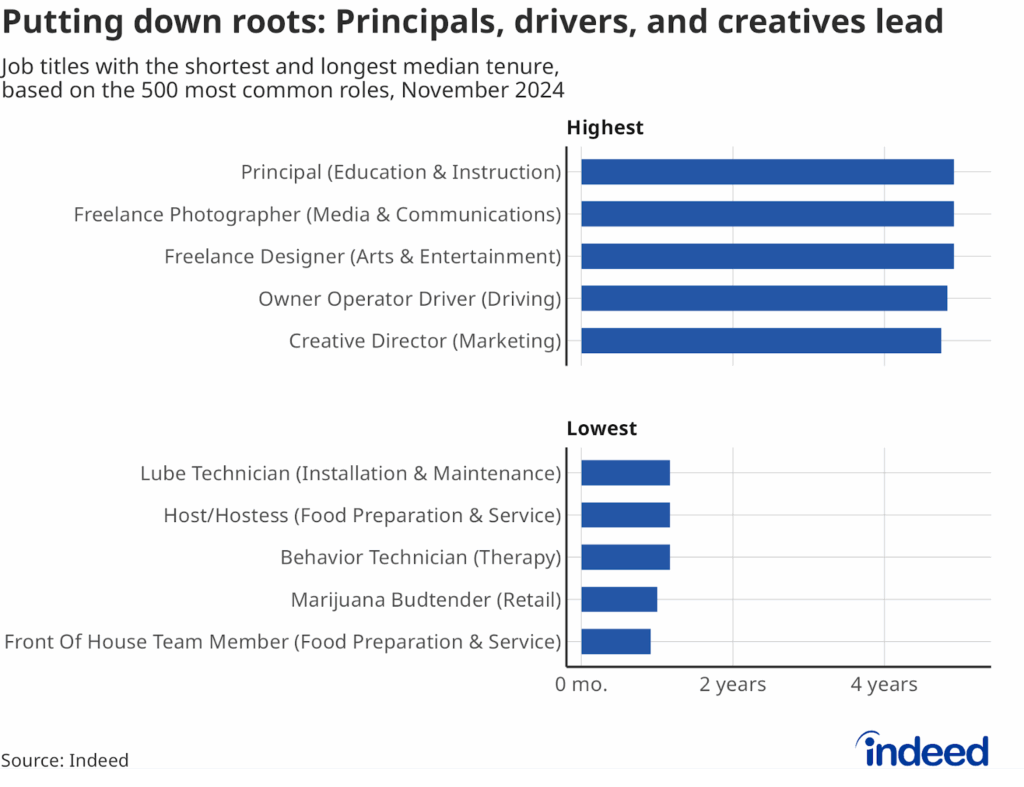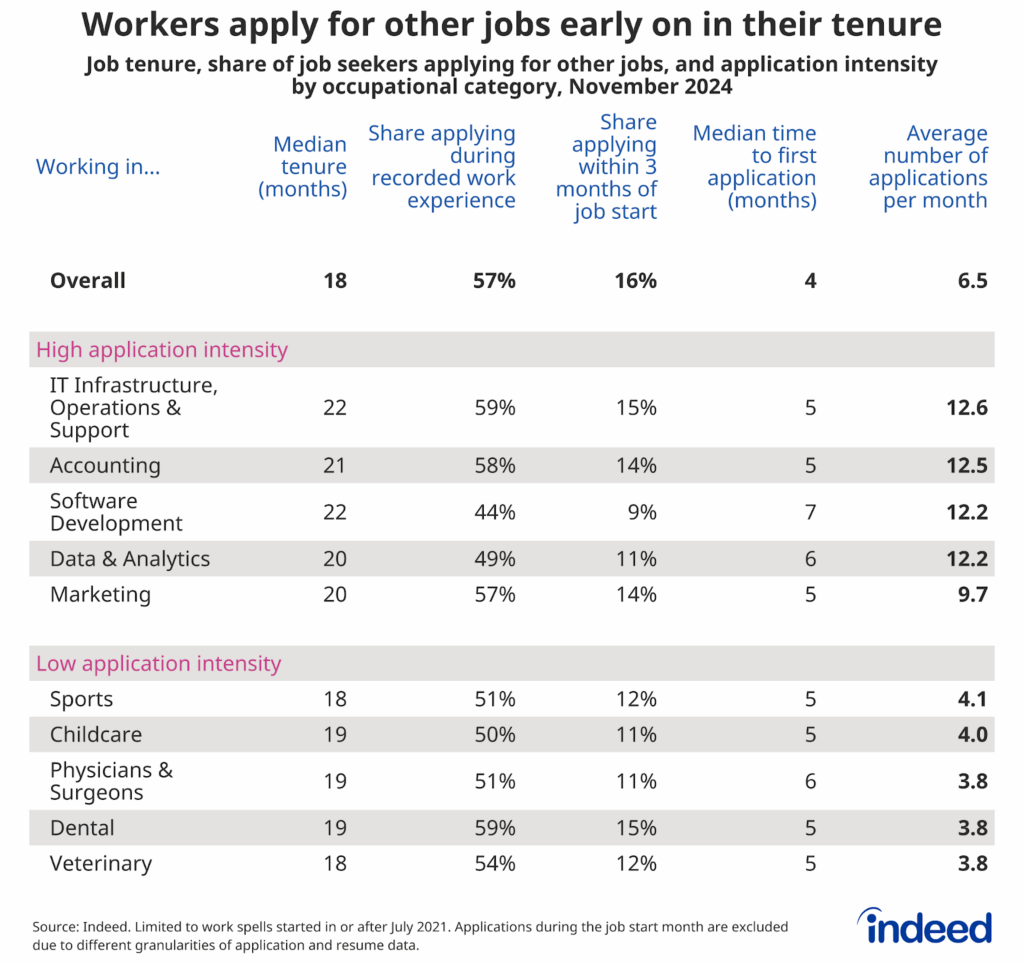Key points:
- The median job seeker on Indeed in the US has been with their current employer for two years and three months.
- Short tenures are especially common in front-line services: More than one-third of job seekers in food preparation & service had been in their job for under a year — twice the share observed in media & entertainment.
- Across the 500 most common job titles of Indeed users, school principals were among the jobs with the longest median tenure (almost five years), and front-of-house team members in the food sector had the shortest (11 months).
- About a sixth (16%) of workers who have started a job since July 2021 applied for another job on Indeed within the first month of their employment spell.
The median job seeker with a profile on Indeed had been in their job for two years and three months as of late 2024, according to Indeed’s job seeker-provided resume data. Workers in typically lower-paying roles, including in retail and food preparation, tend to have shorter stays, while workers in higher-paying and/or more regulated fields — including healthcare and legal work — stick around longer.
Tenure is a key measure of job stability that tracks the length of time an employee has been in their current job (or with their current employer). The data provides valuable insights into the underlying balance between labor supply and demand in various sectors. It also sheds light on where human capital and skills are built, since longer tenure often reflects the accumulation of experience, knowledge, and firm-specific skills.
Short stops and extended stays: Tenure across occupations
Short tenures are particularly prevalent in typically lower-paying occupations, including food preparation & service, retail, and hospitality & tourism. In each of these categories, more than one in four job seekers had been in their job for less than a year as of November 2024, and more than two-thirds for less than three years (the analysis date of November 2024 — one year ago — was chosen to give us a large sample of several tens of millions of work experiences with recent CV updates). On the other hand, the share of workers with short tenure (less than 24 months) was lowest in arts & entertainment, media & communications, architecture, management, and among physicians and surgeons.
Shorter tenure reflects higher churn in these fields. In contrast, occupations with longer tenure durations tend to offer more stable employment, require specialized skills and qualifications, or are subject to entry barriers that deter fluctuation. Some of these roles also reward accumulated experience and networks, creating strong incentives to remain in the same position or organization to build career capital.
In addition, short-tenure, high-churn occupations tend to employ a younger demographic and are often also associated with a higher share of female and migrant workers. Physically demanding work, sometimes irregular hours, and relatively low wages contribute to frequent job changes.

The roles that people don’t leave
Starting with the 500 most common job titles in Indeed profiles, Hiring Lab identified the five jobs with the shortest and longest median employer tenures, respectively.
The typical roles that are held down the longest by Indeed users are (school) principals, drivers, freelance photographers and designers, and creative directors —all with a median tenure of slightly less than five years.
Other job titles show considerably lower job stability. Front-of-house team members in the food industry, for example, typically have very short stints, with a median tenure of 11 months. Other short-tenure occupations include marijuana budtenders (12 months), as well as behavior technicians, lube technicians, and hosts/hostesses in the food industry (all 14 months).
These differences in tenure are driven partly by inherently lower job stability, but may also be the result of differences in the composition of the respective workforces. A high proportion of older workers, for example, would increase average tenure because they tend to stay in jobs longer.

Every occupational category has its jobs that promise the most stable careers. In management jobs, owners and presidents have the longest tenure (more than 8.5 years, at the median), while senior project specialists typically leave after 1.5 years. Police sergeants (seven years and 11 months) stay almost seven times longer than fire watchers (14 months) in the security & public safety domain. In the legal field, solo practitioners (slightly more than eight years) typically have a median tenure 6.5 times longer than law clerks (15 months).
The variation between the shortest and longest tenured jobs is far less wide in childcare. In November 2024, the median babysitter/nanny had been in their job for almost three years, only about twice as long as the typical kids club attendant (one year and four months).

On average, how long do people work in one job before applying for another on Indeed?
Indeed’s anonymized data on employment and application behavior offers a particularly unique view of the time between when a typical Indeed user starts a new job and applies for another. Since July 2021, Indeed has captured online application activity of its users, allowing application behavior to be studied across profiles (for this analysis, we excluded instances where the active job as of November 2024 on the resume started before July 2021).

Between July 2021 and November 2024, the median tenure across occupations was 18 months. Three months into their tenure, 16% had already clicked apply on another job on Indeed. Throughout their recorded work experience, 57% clicked on apply at some point, and among those who did, the average number of applications was 6.5 per month.
The application intensity is particularly high in typical white-collar office jobs. The highest number of applications per month was started by people working in IT infrastructure, operations & support, accounting, software development, data & analytics, and marketing. Among these occupations, data & analytics and software development stick out: The share of people applying to a job is lower, and they do so later into their jobs (typically six or seven months in) than those working in accounting or marketing.
Application intensity is lowest among physicians & surgeons, dental and veterinary workers, and those employed in childcare and sports jobs, all of whom apply between about three and four times per month on average. Persisting shortages in several of these fields (notably physicians, veterinarians, and childcare workers) suggest that labor demand for workers remains strong to make applications comparatively more likely to succeed.
Conclusion
At the individual level, long job tenure can signal a good match between a job and a worker, as well as sustained commitment from both the employer and the employee. It reflects accumulated experience and growing expertise, and is often found in occupational categories and job titles with stable career paths and roles that are inherently rewarding in the long run.
For employers, understanding the drivers of employee tenure can help develop more intentional retention strategies and foster a committed workforce to maintain stable institutional knowledge. For employees, having knowledge of typical tenure in their occupations can help them benchmark their progress, allowing them to make informed career choices and invest in skills on a more strategic timeline.
The data also highlights an important fact: Even while employed, people are constantly on the lookout for new job opportunities. They may be less inclined to take risks during times of greater uncertainty, but they generally keep an eye on the ever-evolving market. On the other hand, many jobs are short-term by design or are more sensitive to structural factors. Employees may leave their jobs more quickly due to difficult working conditions, low pay, or precarious employment. Short tenures are also naturally more common among younger workers, and partly reflect intentional job hopping, skill acquisition, and the pursuit of a better match to one’s values and skillset.
High-turnover jobs tend to be those that offer easy access to employment for marginalized groups, with or without a degree. These jobs often serve as a stepping stone for workers and a source of flexibility for employers.
Understanding tenure, whether long or short, provides both workers and employers with a clearer sense of the labor market and a snapshot of who tends to stay in certain jobs and who tends to move on more quickly.
Methodology
To analyze job tenure patterns, we examine the resumes of over 40 million job seekers with Indeed profiles on a specific reference date and determine, based on their uploaded resumes, the amount of time they have been in their current job or with their current employer.
Job tenure is measured as a reference date set 12 months prior to data collection. This approach helps mitigate potential recency effects in the information reported on CVs, ensuring that tenure estimates reflect a more stable point in time.
Measuring job tenure in job seeker-provided data means that data granularity depends on individual choices. In most cases, work experiences are communicated at the monthly level (e.g., “January 2021 – July 2023”), but some users prefer a coarser granularity (e.g., “2021-2023”) for either part of or their full CV. Accounting for work experiences at yearly granularity does not change the results of this analysis.
The analysis of apply starts among Indeed users is restricted to work experiences that began in or after July 2021, corresponding to the period from which application activity has been measured on a consistent basis. Apply starts are counted if they were recorded in the month following the job start.



